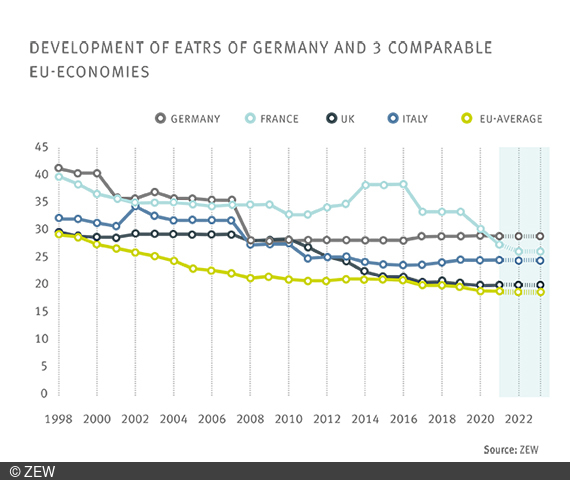ZEW Launches Mannheim Tax Index
ResearchInternational Corporate Tax Burdens at a Glance
Many countries have seen a rapid surge in public debt levels due to the coronavirus pandemic. It comes therefore as little surprise that corporate taxation has become a focus of interest among policymakers as an alternative source of income to bridge these massive financing gaps in public budgets. While previous discussions have mainly focused on how to prevent a global decrease in corporate tax rates as economies try to increase their attractiveness as a business location, the recent shift in tax policy in the US and the UK have steered the discussion into a new direction. With both the UK and the US taking steps to raise company taxes, the question of whether businesses should be required to share the responsibility of covering COVID-19-related deficits through higher taxes could also become more relevant in Germany.
The question of whether this should be brought into discussion depends, amongst other things, on how attractive or unattractive Germany is as a business location compared to other countries in terms of the corporate tax burden. In order to facilitate the comparison of these highly different tax regimes in individual countries, ZEW Mannheim has developed the “Mannheim Tax Index”.
This index can be used to assess and compare effective tax rates for a number of countries (EU 27, the United Kingdom, Switzerland, Norway, the US, Japan, North Macedonia and Turkey). This comparison allows insights into how individual states are faring in terms of their corporate tax burden and how a tax hike or cut would impact on the attractiveness of these countries as business locations. These calculations, which ZEW Mannheim has been conducting on behalf of the European Commission for many years, will henceforth be published for external audiences on a ZEW theme page and updated on an annual basis. The current figures calculated for 2020 can be accessed via this page.
The “Mannheim Tax Index” centres on the average effective tax burden at company level, as this is a key determinant for multinational corporations in their choice of location. The index is therefore calculated based on the taxes on profits as well as on the capital invested by corporations. It takes into account the tax rate burden, how different tax rates interact with one another, as well as the most important rules for determining the tax base, such as regulations on tax depreciations or the valuation of inventories.
In addition to the information on company taxes, the theme page “Mannheim Tax Index” also features four graphs on:
- The development of the average effective tax burden in Germany compared to those of comparable EU economies/the EU average
- A cross-country comparison of effective average tax rates (EATRs)
- An international comparison of effective average tax rates (EATRs) for digital business models
- The model structure of the index

